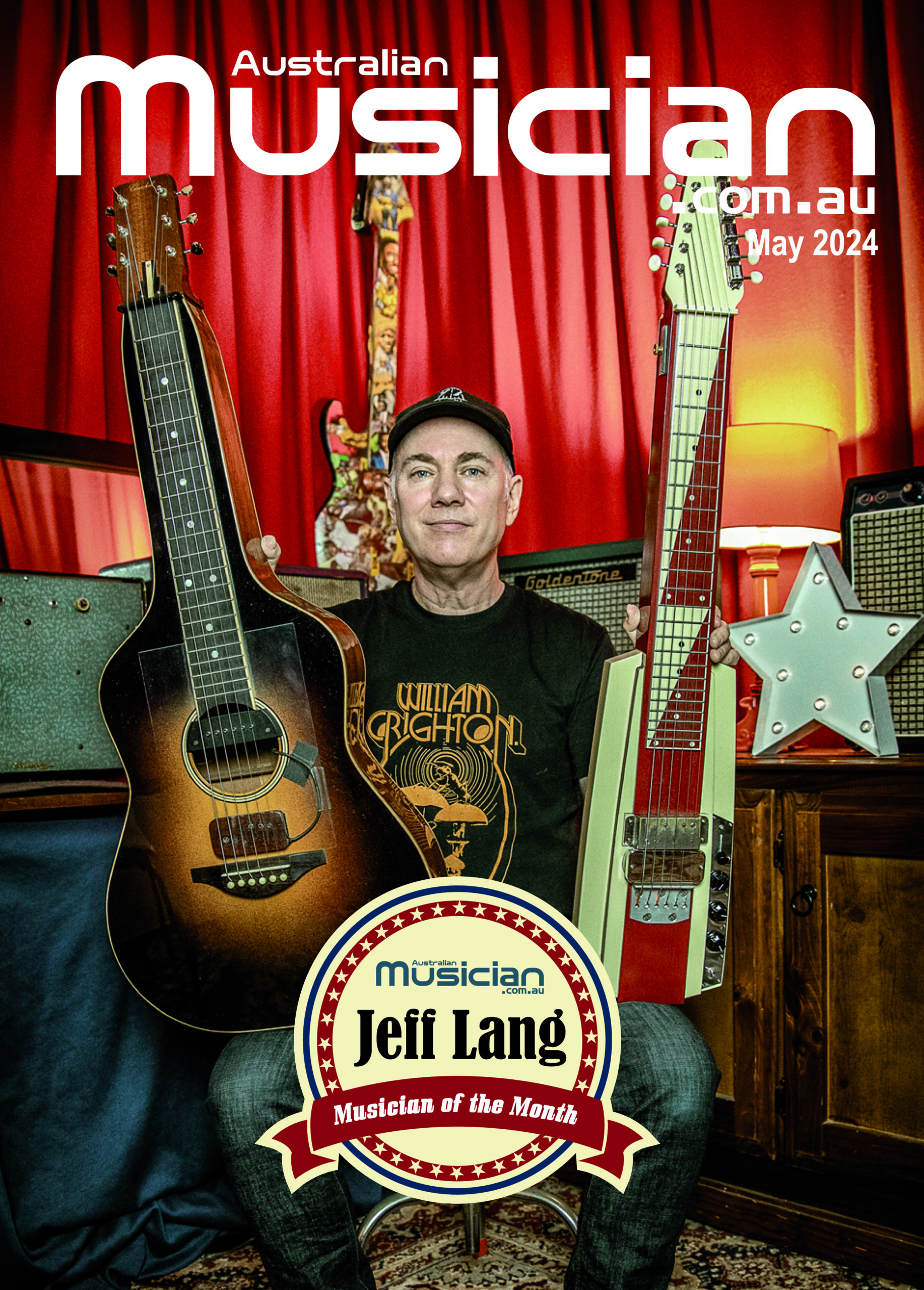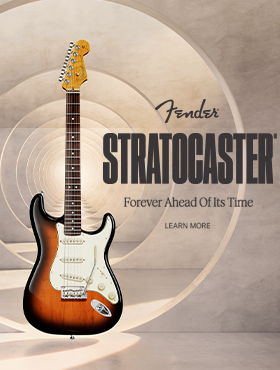
This year, UK 80’s funk-rock icons Level 42 celebrate their 40th year as a band and surprisingly have never toured Australia … until now that is! This superb Mark King-led seven piece band will finally tour Australia and New Zealand for the first time ever this May! Level 42 left their mark on the 80’s with a polished, upbeat, danceable pop/rock sound largely defined by lead singer / bassist Mark King’s thumb-slap bass technique. Catchy hits such as ‘Lessons In Love’, ‘Running In The Family’ and ‘Something About You’ crossed the band from their jazz-funk fusion roots firmly into the mainstream pop charts and gave them a fanbase worldwide. Ahead of the tour Australian Musician editor Greg Phillips spoke to Mark King about his career, gear and the upcoming Australian and NZ tour
Mark, I can’t believe you’ve never played Australia before, how has that not happened until now?
It’s the craziest thing. I think we were supposed to be coming in 1987 when we’d finished opening for Madonna. We were chasing a hit that we had ‘Something About You’, which had done well in the states and I think it had done well in oz too. We were going from LA to Japan to Australia. Unfortunately that was a time when our drummer Phil checked himself into a clinic back in London. The crew and our equipment flew out to Japan ready for the tour and we all limped back to London, thinking what the hell are we going to do now? That would have been our first touchdown but it never happened, so I am so happy that during our 40th anniversary, we are actually going to set foot on your lovely soil and playing for you guys.
What are you looking forward to most about the tour?
We’ve been suffering for our art for 40 years and now I figure, it’s your turn ha! Seriously, I am very proud of my band, they are all good players, really good players. The music that Level 42 play is a very good vehicle for the guys to dig in. The rhythm section in the band is pretty cool and we’ve had a great tradition of having fantastic drummers, starting with Phil back in the beginning, then the great Gary Husband took over from him. Then we had Gavin Harrison for a while and then Bill Cobham sat in with us a couple of times and now we have Pete Ray Biggin on drums and for me as a bass player he is fantastic to play with. That’s why I am excited to bring the band down there because for any young aspiring musicians, it’s not just about people from the 80s who want to reminisce, and there’s part of that of course and there’s nothing wrong with that, that’s the beautiful thing about music, it can be time less but it can also be like a time machine. So many people I have spoken to over the years have said when such and such a song came out, they were going through a break up at uni or they got married to it, that sort of thing which is really lovely. But I also really love the idea of young musicians coming along to see this band and to be inspired and to want to do something like it or at least pick up the baton and crack on from there.
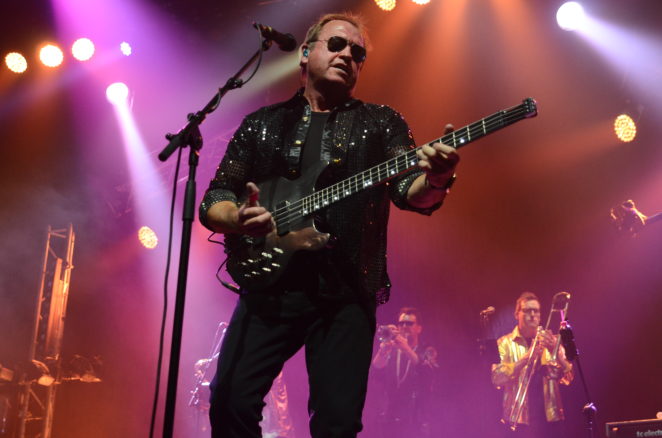 What led you to play slap bass rather than traditional style of playing bass?
What led you to play slap bass rather than traditional style of playing bass?
Drums Greg, I really wanted to be a drummer. It was my misfortune that me best friend Phil Gould … we were both drummers growing up here on the Isle of White in the UK. When we got together as Level 42 at the end of 1979 and started recording in 1980, Phil had the drum kit, I didn’t have any drums. I was working in a music shop and I had the opportunity to pick basses off the wall when it was quiet, which was most of the time. My heroes were Larry Graham, Stanley Clarke and Louis Johnson. What I particularly liked about their playing was the percussive approach. So I just started thumping the bass. The technique I have is even more percussive, more akin to playing congas or bongos as opposed to Larry Graham’s approach, which is just really good right hand thumping. It was really just the rhythmic thing, the drum thing. Of course it was my really good fortune that in 1980, the people at home had had their fill of the punk thing, which was ‘the worse you play, the better it is’! Then suddenly there was this movement, this Brit funk thing that was coming up underneath and it was hip to be able to play well again. The first record we released Love Meeting Love was put out on an independent label, Elite records and it came out on a white label, so the funk mafia … this collective of DJs back in 1980, were playing this 12 inch in the clubs and it was widely assumed that we were an American band. So we found ourselves in a very lucky situation of having a ready made audience in this thing called Brit funk. We were able to go out and do the soul-weekenders and all-nighters. It was such a great way to cut your teeth, just jumping in a van, bombing up the motorway, getting out and setting your gear up, waiting another 8 hours until you get to play but there’s the audience lapping it up and every musician needs an audience.
You mentioned Larry Graham, you got to jam with him fairly recently didn’t you?
Yeah he was so sweet. I got a call from his manager, it was six years ago now and he was saying that Larry was playing at the Jazz Cafe in Camden, London and did I want to do like a bass-off? I said yes for sure, so that was really lovely. As happens, somebody put it up on YouTube for all to see. The following year Larry got a call from the North Sea Jazz Festival asking if we could do this at the jazz festival. That was a full on gig and we did a couple of Level 42 songs as part of his set as well, he is the sweetest man and a wonderful musician. Funk just oozes out of the guy. What was really special about that show was that toward the end of the set, who should walk on stage but Prince. Prince absolutely adored Larry and Larry had been the bass player in his line up for ten years or so. When he heard Larry was doing the North Sea Jazz Festival, he flew in and came on stage and that was a blast and then on came Carlos Santana, so we had this amazing jam on stage. I was doing what I always do, standing there with my jaw on the floor thinking this is amazing. It has happened a few times in my life. Back in ’85 I was part of the Prince’s Trust All Star Gala house band. It was a hell of a band which boasted Elton John on piano, Clapton on guitar, Mark Knopfler on guitar, Phil Collins on drums, Midge Ure on guitar and myself on bass but the guys coming on and singing were David Bowie and Mick Jagger, Tina Turner did a couple of songs, Rod Stewart, George Michael and then last of all Paul McCartney. It was just the most amazing thing and I think I would have been 25 years old at the time and it’s the kind of thing where you stand there thinking, this can’t be happening.
What’s the secret to being able to sing and play bass at the same time?
For me, I just started doing the same things at the same time. I’d never really sung before Level 42 and never played bass as a main instrument before. To actually jump in and within 3 months of having started jamming together at the Gielgud School of Music on Monday nights to be going out and gigging on the few songs that we had. One song that we had was Love Meeting love, that was an instrumental to begin with and Andy Sojka from Elite Records said you should get a singer and come up with a melody and some lyrics and then if you do that, I’ll record it. It was one of those key moments. None of us fancied getting anyone else ‘cos we just liked doing it as four friends. I came up with the melody and Boon who was crashing with me at the time, wrote the lyrics and that’s how we started. For me it really, that’s all I have done as a bass player is to play bass and sing at the same time. But if you want a really good tip, don’t concentrate too hard on either one. I know that if we play songs we havent played for a while and I start struggling with the lyrics, I fuck the whole thing up, the bass lines, the whole thing.
Tell me about your bass and amp journey over the years. Did it take you a while to get the combination of bass and amp that you liked?
I’ve not been a massive changer of gear over the years. Once again, another good quirk of fate was six months into playing, Polydor Records offered us an advance of 5,000 pounds, which doesn’t sound much and believe it or not, really wasn’t that much back then either. For that amount we had to get a van, a rhodes, mini moog, Boon needed to get stack and a guitar. I needed to get a bass and I didn’t have enough for a bass rig either. My share was 500 pounds. I was walking through Shaftsbury Avenue, this would have been the second half of 1980 and I went into Sounds, a music shop. There was a Jaydee Supernatural bass just there on a stand. To me it looked like an Alembic so immediately I was thinking Stanley Clarke and whatnot. I picked it up and it felt absolutely fantastic. I asked them how much it was and they said 600 pounds and I told them I only had 500. They said it’s sale or return so I’ll give the guy a call. They phoned John Diggins up and he was really sweet and said yeah let the guy have it but rather meanly they wouldn’t give me a case with it, so I walked off with it in a bin liner.
When we got a bit more money I got a JC200 amp head. I’m sure you are familiar with the Roland JS120’s, which were popular at the time. What was lovely was that they had a fabulous chorus effect and they also did this standalone 200 watt head, which I bought and ran that through a Marshall 8×10 guitar cab. They were 10” speakers because I was very unimpressed with the responsiveness of anything bigger than 12” speakers and 15” were definitely out of the question. There were loads of 18” cabs around because of the whole punk thing but they couldn’t handle the slap thing at all. So I was running this JC200 head through a Marshall 8×10 guitar cab and that really served me well for the next 12 months. We were doing so much touring that as you could imagine the whole thing started farting dreadfully as I was taking the cones out and stuff. At that time a company had just started in Essex, east of London called Trace Elliot. I dropped into their store one day and saw this fantastic 8×10 rig, it was on wheels so you could cart it around. That was really important for us because we were lugging our own gear. That started a really good relationship between me and Trace Elliot certainly for the next five years. I used Jaydee all that time too but by 1982 Trace Elliot asked if I would go to the Frankfurt Music Fair and do something on their stand, which I was happy to do and there I met Rob Green. He was just starting this company called Status Graphite. He was specialising in carbon fibre and they were headless guitars. I struck up a relationship with him and the following year he gave me a bass which I really enjoyed playing. I found it really responsive.
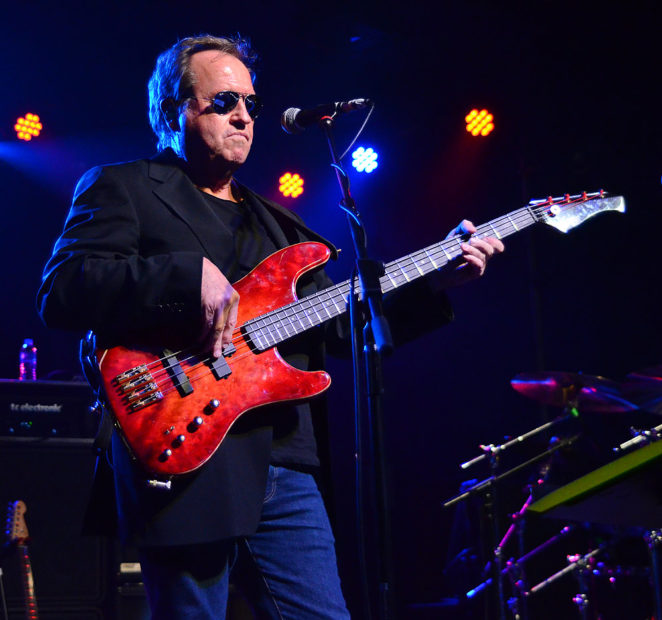
By the time we got to ’85 and we were touring the States, Alembic gave us a shout and they showed up at a show north of San Francisco. It was really strange, this guy just showed up with this little briefcase, which he opened up and took out all of these bookmatched woods. He said we’d like to make you a couple of basses Mark, would you like to choose what wood you’d like us to use? I chose a beautiful cocobolo and a beautiful flame maple. Sure enough, off they went and six weeks later I took delivery of this pair of matched Alembic basses and it was wonderful. Then I had a bit to do with Mesa Boogie because the Americans were terrible, they were always throwing gear at you. All this time though I was using Rotosound bass strings. The gauges I was using really stem from the bass I used on the first recording, an old Gibson EB something, a semi-acoustic thing, a medium scale bass. So the strings on it were very bendy and very light. When Rotosound told me they wanted to make some strings for me, they asked what gauge and I said 30, 50, 70, 90, which was unheard of back then because most were starting at 45 and going to down 105. Anyway they were absolutely brilliant. The problem with the lighter strings was also with the sound that I have, it actually starts with the strings, that twang, a very high end attack on it. The thing is … being a sweaty little twat, my strings would go dull after about 30 minutes of playing.
These days I’ve really tied up with Rob Green and I have been using King basses since 1999-2000. He rang me up and said you know what, we never actually sat down and tried to come up with a bass for you. So he came down to my house on the Isle of Wight and we had a really lovely day drinking wine and looking at shapes and I told him I wanted something a bit more guitar-like as opposed to the old Fender lumps. He came up with the goods for me and I have been using the Status King basses ever since. We have gone through some changes too, the one I am using at the moment is called a T-bass which is actually back to much more Fenderesque vibe, more like a Jazz. It’s got a Jazz bass pickup on the bridge and P bass on the neck pickups. That was inspired by a project a couple of years back with Stewart Copeland, Vittorio Cosma and Adrian Belew called Gizmodrome. We recorded an album in Milan which was great fun to do, pretty wild music. The King bass I was using just wasn’t cutting it really. I picked up a 1967 Jazz bass in the studio and straight away it fitted in. I was using a plectrum, so not slapping at all because your first job is to do what is right for the music. So it gave me the opportunity to get in touch with Rob and say I want you to knock one of these up asap, which he did and they are lovely. These are the basses I am using at the moment. The amps I am using now are MarkBass. They have a great reach around the world and a keenness for making sure you get the gear you need. (Mark King has been using a MarkBass Signature Little Mark Vintage Gold Line head with a standard MarkBass 104HR cab)
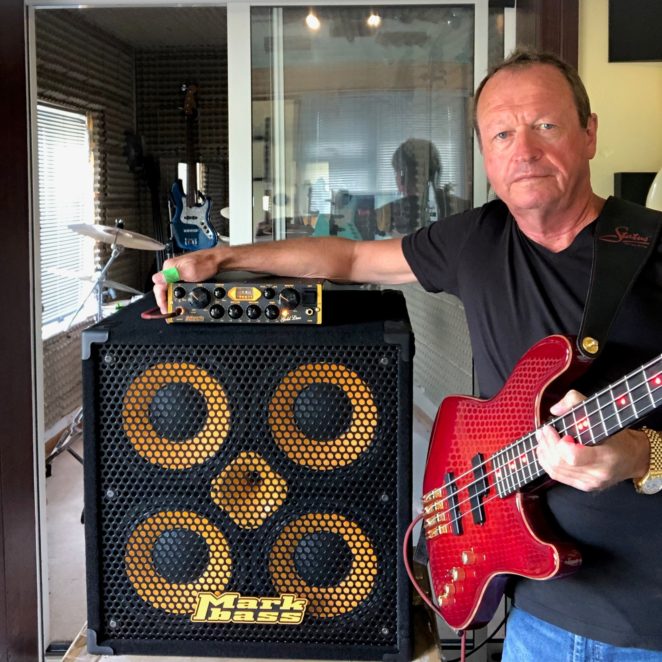
Because you’ve never been to Australia before, how will you approach the set list?
One of the benefits of doing something for 40 years is you learn what makes a set work well and the dynamics of it. You have the bankers that you know people are going to want to hear. The way that I have rationalised it over the years is to start with a cracker, go to a deeper cut then go back to a hit again, deeper cut, hit again. The hardcore fans are there for the muso stuff and they know that once they get through the hit, there’s the other stuff we get stuck into a bit. I’ve got a blinding 90 minute set and the band is a seven piece, including 3 piece brass and it’s going to be great. Don’t worry about the set mate, I’ve got it all sorted.
What are you most proud of in your career?
Goodness! Honestly Greg, I think the very fact that we are still here. This will be our 40th anniversary and that’s no walk in the park. We have actually done it, it is there. The fact that I have been able to do it and so many of my peers of the time faded away, it’s testament to something. I am really proud of that and that we keep going and the musicianship, we stay true to that. From my heart, I am so excited to be coming down there after 40 years. The band is really pumped for this, so lots of love to all you Aussies and I’ll see you soon.
TOUR DATES
Thursday, May 14: Astor Theatre, Perth – Tickets
Friday, May 16: Palais Theatre, Melbourne – Tickets
Monday, May 18: Enmore Theatre, Sydney – Tickets
Wednesday May 20: The Civic, Auckland – Tickets
Tickets on sale Now!
www.showcasegroup.com.au

